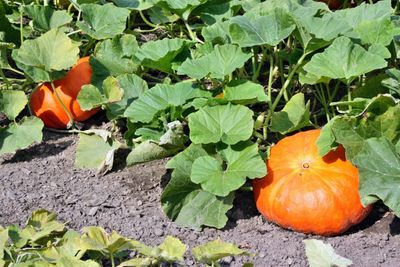When to Trim a Pumpkin
Pumpkin vine pruning, as long as it is done judiciously, doesn’t harm the plants, as is evident by my inadvertent hacking of the vines while mowing the lawn. That said, cutting them back hard will reduce the foliage enough to affect photosynthesis and affect the plant’s health and productivity. Pruning is done to achieve one or both of the following: to reign in the plant’s size, or to promote the growth of a select pumpkin per vine. Otherwise, pumpkins can be trimmed back whenever they are getting in the way as long as you are prepared to lose potential fruit. Pruning pumpkin vines is necessary for folks growing “the big one,” those trying to attain the lofty goal of winning the state fair’s blue ribbon for giant pumpkins.
How to Prune Pumpkins
If you are in the running for the largest pumpkin grown in your area, you already know how to prune a pumpkin, but for the rest of us, here’s how to cut back a pumpkin. First, protect your hands from the prickly vines and glove up. With sharp pruning shears, cut secondary vines growing from the main vine. Measuring from the main vine, make the cut 10-12 feet (3-4 m.) down the secondary line. Cover the severed ends of the secondary vine with soil to prevent disease from entering the open wound and to reduce water loss. As they develop, remove the tertiary vines from the secondary vines. Cut close to the intersecting secondary vines with pruning shears. Measure the main vine and cut it to 10-15 feet (3-4.5 m.) from the last fruit on the vine. If the plant has multiple main vines (a plant may have 2-3), then repeat the process. Wait to cut the main vines until the fruit has developed enough to determine which fruit is the healthiest looking on the vine, then prune the vine to remove weaker pumpkins. Continue to cut the main vine as it grows to allow the plant to put all of its energy into the remaining fruit instead of vine growth. Again, bury the cut ends of the vine in the soil to protect from disease and retain moisture. Move the secondary vines 90 degrees from the main vine so they don’t overlap as they grow. This provides more room for the fruit to develop and allows for better air flow and access to the vines.
